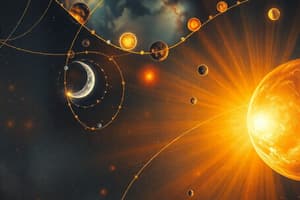Podcast
Questions and Answers
What initiates the formation of stars?
What initiates the formation of stars?
- A cloud of dust and hydrogen gas (correct)
- A collision of planets
- The fusion of helium nuclei
- The explosion of a supernova
What role does gravity play in the formation of a protostar?
What role does gravity play in the formation of a protostar?
- It causes the protostar to expand rapidly
- It prevents the formation of helium
- It cools the particles down
- It causes dust and gas to come together (correct)
During the main-sequence stage, what balances the inward force of gravity on a star?
During the main-sequence stage, what balances the inward force of gravity on a star?
- Thermal expansion of gases
- Rotational motion
- Outward pressure from nuclear fusion (correct)
- Gravitational pull from nearby stars
What happens to smaller stars when their hydrogen fuel begins to deplete?
What happens to smaller stars when their hydrogen fuel begins to deplete?
What is the last stage of a smaller star's lifecycle after it expands into a red giant?
What is the last stage of a smaller star's lifecycle after it expands into a red giant?
What element is primarily formed through nuclear fusion in the early stages of a star's lifecycle?
What element is primarily formed through nuclear fusion in the early stages of a star's lifecycle?
What marks the transition of a star into a red giant?
What marks the transition of a star into a red giant?
What is the final fate of a white dwarf in the absence of further fusion?
What is the final fate of a white dwarf in the absence of further fusion?
What occurs during the main-sequence stage of a star's lifecycle?
What occurs during the main-sequence stage of a star's lifecycle?
What happens when the hydrogen fuel in smaller stars runs out?
What happens when the hydrogen fuel in smaller stars runs out?
What is formed as a result of the collapse of a super red giant?
What is formed as a result of the collapse of a super red giant?
What is the end stage of a smaller star after it becomes a red giant?
What is the end stage of a smaller star after it becomes a red giant?
What phenomenon occurs during the supernova of a massive star?
What phenomenon occurs during the supernova of a massive star?
How is a neutron star formed?
How is a neutron star formed?
What characteristic defines a black hole?
What characteristic defines a black hole?
What determines whether a neutron star will collapse into a black hole?
What determines whether a neutron star will collapse into a black hole?
What role do stars play in the creation of elements in the universe?
What role do stars play in the creation of elements in the universe?
What happens immediately after a supernova occurs?
What happens immediately after a supernova occurs?
Flashcards
Stellar Nebula
Stellar Nebula
A cloud of dust and gas in space where stars are born.
Protostar
Protostar
The early stage of a star's life, where gravity pulls together dust and gas.
Nuclear Fusion
Nuclear Fusion
The process where hydrogen atoms fuse together to create helium, releasing energy and light.
Main Sequence Stage
Main Sequence Stage
Signup and view all the flashcards
Red Giant
Red Giant
Signup and view all the flashcards
White Dwarf
White Dwarf
Signup and view all the flashcards
Neutron Star
Neutron Star
Signup and view all the flashcards
Black Hole
Black Hole
Signup and view all the flashcards
Smaller Stars
Smaller Stars
Signup and view all the flashcards
Helium Fusion
Helium Fusion
Signup and view all the flashcards
Red Giant Phase
Red Giant Phase
Signup and view all the flashcards
Bigger Stars
Bigger Stars
Signup and view all the flashcards
Super Red Giant
Super Red Giant
Signup and view all the flashcards
Supernova
Supernova
Signup and view all the flashcards
Study Notes
Star Lifecycle
- Stars form from stellar nebulae, clouds of gas and dust.
- Gravity pulls the dust and gas together, creating a protostar.
- Protostars heat up as particles speed up.
- Nuclear fusion (hydrogen to helium) begins at extreme temperatures.
Main Sequence Stage
- Nuclear fusion creates outward pressure, balancing inward gravity.
- Stars stay stable in this stage for millions or billions of years.
- Our sun is in the main sequence stage.
Smaller Stars (like our Sun)
- Hydrogen fuel runs out, and fusion weakens.
- Gravity overpowers fusion, causing the star to collapse and heat up.
- Helium fuses into heavier elements (up to iron).
- The star expands to a red giant, potentially engulfing nearby planets.
- Helium fusion stops, and the star collapses into a white dwarf.
- The white dwarf gradually cools, becoming a black dwarf over billions of years.
Bigger Stars
- Bigger stars use their hydrogen fuel much faster.
- They expand into super red giants, creating elements up to iron.
- Fusion stops, causing a catastrophic collapse and supernova explosion.
- Supernovae create elements heavier than iron, releasing immense energy.
- The remnants become either neutron stars or black holes.
Neutron Stars and Black Holes
- Neutron stars form from the collapsed cores of massive stars.
- Electrons combine with protons, forming densely packed neutrons.
- High-mass neutron stars can collapse into black holes.
- Black holes pull in everything, even light.
- Black holes are detected by their gravitational effect on nearby objects.
Studying That Suits You
Use AI to generate personalized quizzes and flashcards to suit your learning preferences.




